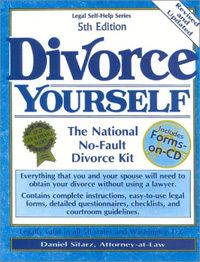Separation
Often the first step taken in the process of getting a divorce is for one spouse to move out of the shared residence. This might just be a trial separation while they decide if divorce is imminent or if they might get back together, or this might be a definite step in the initiation of the divorce. If it is the former, then this is not a legally recognized separation, and any assets or debts created during this time are still jointly owned.
When people refer to "legal separation" they usually mean that period of time they are required to live apart before they can file for divorce. Most states don't actually have a "legal separation," just the separation requirement, which entails living (and sleeping) in different locations at all times. Even getting back together for short periods of time may reset the clock for the separation period. Separate bedrooms in the same house do not constitute a separation. Like for the final divorce, there can be an agreement to divide property and temporarily establish spousal support and child custody. Any assets or debts accumulated during the separation belong to the individual rather than the couple.
Sometimes, people choose a legally recognized separation in lieu of a divorce, meaning the couple is still legally married but living apart indefinitely. This arrangement may be preferable for insurance or other reasons.
Filing a Petition
People can only file for divorce in the state where they live and must have already met the separation requirements.
Filing for divorce, also called filing a "Complaint for Dissolution of Marriage," requires appropriate forms to be completed, a fee paid and the papers filed with the district court in the appropriate county. If you're using an attorney, the attorney will help complete the forms and file them. If not, you're usually on your own. The court personnel will not answer legal questions or help with paperwork.
Part of the petition for divorce is the "grounds for divorce." Even when filing for a no-fault divorce, there has to be a stated reason. Many states simply have a single available ground for no-fault divorce, such as "irretrievable breakdown of marriage" or "irreconcilable differences." Other states have three or four grounds. Fault-based divorces have varied grounds depending on the state.
Another part of the petition includes a listing of items that will be at issue such as the residence, cars and other shared possessions.
Notifying the Spouse
Once you file the complaint, your spouse has to be notified, or served. You (or your lawyer) must submit to the court proof that your spouse has been formally notified. Usually, the spouse can simply sign what is sometimes called a Voluntary Appearance document. If your spouse signs a Voluntary Appearance document, then he or she simply agrees to everything in the complaint and does not have to respond. Otherwise, he or she must formally respond, or file an answer, within a specific period of time -- usually 20 to 30 days. And, once he or she responds, there is another waiting period before a hearing can be set.
If your spouse is served and does not answer, then the judge can grant you everything requested in the complaint.
If your spouse cannot be located, then usually a "service by publication" can be filed. In this case, notice about the divorce appears in a newspaper serving the county where your spouse last lived. This method for service usually allows a longer response period.
Temporary Hearing
Because a trial can be a year away, there may be a "temporary hearing" (also called a motion) to establish temporary child or spousal support and other issues. Some common requests for "temporary" relief include:
- Request for temporary custody of minor children and for temporary child support
- Request for exclusive use of the marital home
- Request for exclusive use of motor vehicle
- Request for injunction to make sure health insurance isn't canceled
- Request for injunction to make sure neither party can access a joint investment/brokerage account until the further order of the court
- Request for award of attorney's fees, meaning one spouse pays the other's fees
- Request for spousal support or alimony
After the temporary hearing, there is often a long wait. That time is usually used to get situated in the new, separate living arrangements and begin thinking about the permanent settlement.
The Agreement
Often the most important and/or difficult parts of the divorce is agreeing on how to divide property and debts and establishing child custody and spousal support. Those items have to be detailed in a written agreement. If it can be done fairly without going to court, then that's better for everyone. The agreement outlines the rules and states what conditions each spouse has agreed to. It is a legally binding contract and can have two primary purposes:
- It can settle issues for the period between the initial separation and the time of divorce. Sometimes separations can last several months or even years, so it is important settle all of the necessary issues in writing so you're covered during that time period. (This is done at the temporary hearing mentioned above.)
- It can be the final agreement and legal document used to settle all marital issues in order to get a final judgment or decree for divorce granted by the judge.
If both spouses are using attorneys, then the attorneys will gather financial and other information from their clients and the opposing spouse (this is the discovery stage) and meet to negotiate the terms of the settlement on their clients' behalf (see How Lawsuits Work for more information about the discovery process.) If you can't reach an agreement using this method or a collaborative-law method, then you may choose to try a mediator. With mediation, as mentioned earlier, the couple is in charge of the negotiation. Some states require mediation if you can't easily reach an agreement. If mediation doesn't work, then the next step is to take the matter to court and let the judge decide.
Trial
When you take a divorce to court, it can become a true battle. It is the attorney's job to "win" the case for his or her client -- to seek what is in the client's best interest. That inherently creates a more hostile environment. Of course, if the case has made it to court, it's probably pretty hostile anyway.
Usually, divorce trials are held with only a judge, no jury. Because many of the issues that must be addressed during this process are interrelated, there is sometimes a specific order to how things are addressed. A typical order may be:
- Establishing entitlement to a divorce
- Arranging child custody and visitation rights
- Settling financial aspects and property distribution
- Arranging child support
- Arranging spousal support
The judge bases the final decision on the evidence presented and usually makes a decision right away or within hours.
Finally, if a spouse is not happy with the outcome, he or she has the right to appeal. If the appeal is granted, the matter goes back to court.
Now let's look at the division of property and custody.










